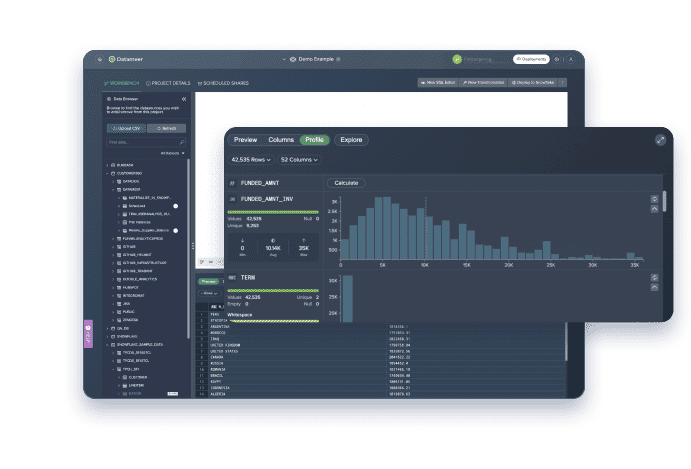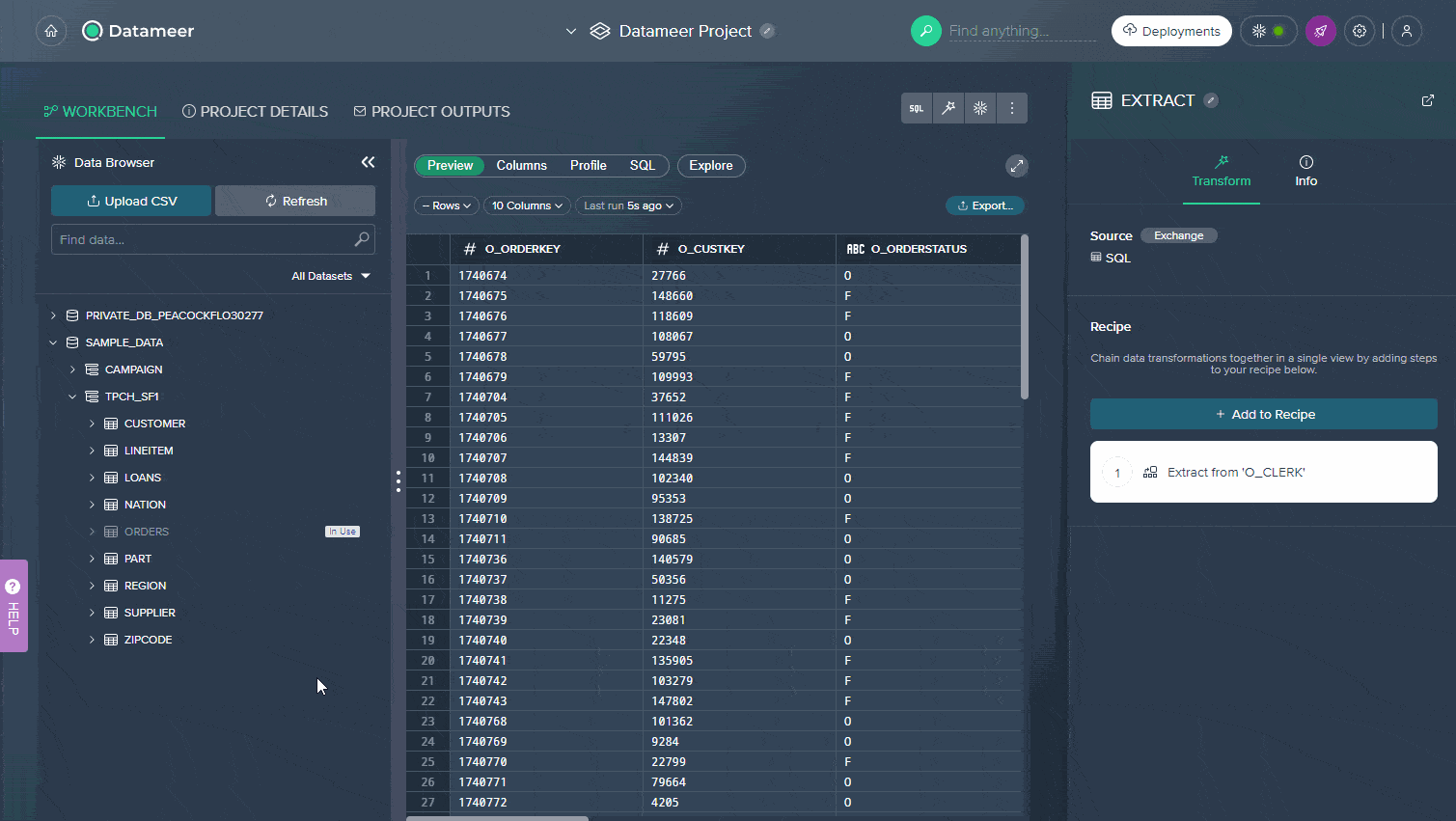How built-in data profiling accelerates your analytics cycle
- Stephen Butts
- April 17, 2023

Data profiling is a key part of any data analytics strategy, and it can help businesses get greater knowledge on the authenticity, comprehensiveness, and accuracy of their data. But traditional approaches to this process such as manual analysis take up time-consuming effort from teams as they search for potential issues in datasets. This kind of delaying slows down your organization’s ability to gain valuable insights that could drive decisive actions based on data.
Built-in data profiling is a time-saving tool that can make the analytics cycle easier and faster by instantly recognizing any data quality issues. Through this, teams are able to promptly check for inaccuracies in their data, rectify them quickly, and move on swiftly to the analysis phase; allowing businesses to save valuable minutes or days worth of labor!
What is data profiling?

By conducting data profiling, organizations are able to guarantee the accuracy and reliability of their analytics. Data profiling is a critical procedure that assesses multiple aspects of data including missing values, incorrect data types, and inconsistencies in order to ensure its quality. Without it, analytical results could be unreliable or even misleading.
Data profiling is an integral part of data analysis, and involves the usage of effective software tools to analyze large sets of data. The generated reports will highlight any potential issues with quality through insightful information such as distribution values, type information, minimums/maximums etc! By leveraging these powerful insights into your datasets you can better inform decisions about the accuracy and reliability of the underlying structure.
Rather than manually performing data profiling, you can use integrated tools within analytics platforms to automate the process. These built-in solutions make use of sophisticated algorithms in order to uncover any potential quality issues far more quickly and accurately.
Utilizing the built-in data profiling tools can benefit any data team, as it helps them become more efficient and increases the accuracy of their analytics results. Compared to manual analysis methods, these tools are much faster at detecting any potential issues with quality or errors in the datasets. It also significantly reduces preparation time when making decisions; allowing organizations to act quickly and decisively on important matters.
Here are several advantages of using built-in data profiling to accelerate your analytics cycle:
Identify data quality issues faster

Built-in data profiling offers an advantage that traditional manual analysis techniques cannot match. With the use of algorithms, it quickly and accurately detects anything from missing values to wrong data types or outliers in your datasets – allowing you to save ample time compared to when manually assessing them! Data teams no longer have to spend hours combing through mountains of information for potential discrepancies; instead they can gain valuable insights within a fraction of the usual time thanks built-in data profiling.
Built-in data profiling not only saves time, but also enables data teams to uncover possible issues that manual analysis may have overlooked. Algorithms used in built-in data profiling leverage statistical analysis and other innovative methods to spot potential problems. Consequently, it leads to a more thorough comprehension of the existing quality concerns embedded within the dataset.
Reduce data preparation time
Data preparation is a fundamental part of the analytics process, yet it can be time-consuming and tedious. Fortunately, through built-in data profiling, teams no longer need to spend countless hours manually spotting potential mistakes within complex datasets but can instead automate this task with ease – freeing up more time for honing in on the true analysis at hand!
With the assistance of built-in data profiling, organizations are able to decrease their time spent on data preparation and expedite critical decisions in the face of ever-changing market conditions or other external variables. By leveraging this technology, organizations can make quick yet informed choices that will help them stay ahead of competition.
Improve data accuracy
Through data analytics, business leaders can acquire meaningful and accurate insights which will aid in their decision-making. To enhance the precision of those findings, embedded data profiling is an ideal solution that identifies quality issues within datasets which may have been otherwise overlooked when analyzed manually. By resolving these discrepancies, organizations are able to refine the accuracy of results produced by their analytics and make more informed decisions for a successful future!
Data accuracy is not the only benefit of data profiling – it can also bring trust to your organization. By displaying a commitment to quality and reliability in your data, you show that decisions made based on this information are sound, thus reinforcing effective governance processes throughout your company.
Increase data team productivity
Built-in data profiling helps bolster your data team’s productivity by automating onerous tasks, so they can focus their energy on more important activities. This automation significantly reduces the need for manual analysis while enabling them to put all of their efforts into initiatives like data modeling, analyzing statistics and producing visualizations.
By leveraging cutting-edge data profiling solutions, businesses can achieve their analytics goals in record time. This provides a competitive advantage by enabling your organization to stay ahead of market shifts and identify potential opportunities quickly, as well as maximize operational efficiency.
Data profiling best practices

To maximize the effectiveness of built-in data profiling in your analytics operations, here are some top strategies to consider:
- Uncover the insights of your data: To capitalize on data profiling and produce favorable results, it is important to understand your dataset as well any potential issues. With this knowledge in hand, you can then modify the algorithms so that they identify where quality may be lacking. Acquiring insight into these areas will grant you maximum benefit from data profiling efforts.
- Simplify usage: Tuning your data profiling algorithms can enable you to pinpoint quality issues or prioritize distinct datasets. By mastering how to adjust the settings of automated processes, you can fully exploit your data profiling tools and realize desirable outcomes.
- Streamline data preparation: To guarantee pinpoint accuracy in your analytics results, you should consider utilizing automation tools to automate data preparation activities like sorting, transformation and normalization. Automating these tasks will speed up the prepping process while still guaranteeing reliable outcomes.
- Monitor data quality: It is crucial to maintain a hawk-eye vigil over data quality if you wish for your analytics to be dependable and current. If any issues are identified quickly, it will avert unwanted outcomes in the future so that you can stay sure of your conclusions always.
Accelerate your analytics cycle with Datameer
Evaluating datasets can be a tough task for anyone, making it difficult to identify where to begin with analysis.
Don’t worry if you feel like your data isn’t ready for analysis – many people have the same problem! Data profiling is essential to make sense of datasets and it’s something that a lot of people don’t realize. Utilizing this process can help unlock insights in your dataset so that you can get more out of it.
Datameer delivers a user-friendly data profiling tool that makes it effortless to uncover the shape and quality of your datasets. With only some clicks, you can easily view how your data is arranged and pinpoint any issues needing resolution before commencing investigations.
So get started with Datameer, and streamline your data transformation processes today!


